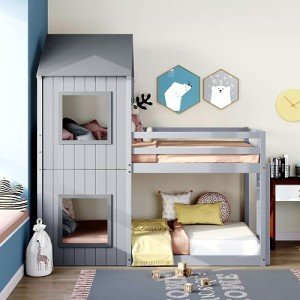The Ultimate Guide to Kids Bunk Beds: Maximizing Space and Fun
With the increase of vertical living and smaller spaces, the appeal of bunk beds has actually skyrocketed amongst households. news offer a useful sleeping solution, specifically in shared spaces, however they also bring an element of fun into a child's life. This thorough guide looks into the functions, advantages, and factors to consider of kids' bunk beds, making it much easier for parents to choose the best bed for their little ones.
Features of Kids Bunk Beds
Bunk beds are versatile pieces of furniture that serve more than a single function. Here are some key functions to consider:
| Feature | Description |
|---|---|
| Product | Bunk beds can be built from wood, metal, or a combination of both, providing varying levels of toughness and style alternatives. |
| Safety Features | A lot of bunk beds come equipped with guardrails, safe and secure ladders, and capped assistances for safety, particularly crucial for young children. |
| Style Variety | Choices vary from classic styles to modern-day designs, making sure a match for any room decoration. |
| Space-Efficiency | Bunk beds use vertical space, making them perfect for smaller rooms. |
| Convertible Options | Some designs can be converted into two different beds, supplying flexibility as kids grow. |
| Storage Solutions | Some bunk beds feature integrated storage drawers or racks, helping to keep the space arranged. |
Advantages of Kids Bunk Beds
Investing in a bunk bed features numerous benefits:
- Space Saving: Bunk beds maximize flooring space, permitting more backyard or storage solutions.
- Enjoyable Factor: With a bunk bed, kids have a place that cultivates creativity and companionship throughout sleepovers or playdates.
- Economical: Instead of buying 2 separate beds, a bunk bed can accommodate 2 kids simultaneously, saving money in the long run.
- Adaptability: Many bunk beds can be taken apart or transformed into twin beds, making them a long-lasting investment as kids's needs change.
- Social Interaction: Bunk beds motivate household bonding and friendships, supplying a welcoming space for kids to share stories and laughter.
Considerations When Choosing a Kids Bunk Bed
When choosing the best bunk bed for a child, moms and dads must take into consideration different aspects:
- Safety Standards: Ensure that the bunk bed complies with safety guidelines and features important safety functions.
- Age Appropriateness: Different models deal with different age groups. For example, traditional bunk beds may not be ideal for more youthful children.
- Space Dimensions: Measure the bedroom to guarantee the bunk bed fits appropriately, permitting space to walk around conveniently.
- Weight Capacity: Consider the weight load of each bed and guarantee it accommodates the kid's weight easily.
- Style Preferences: Letting kids take part in the selection process can assist them feel more thrilled about their new bed.
Kinds Of Kids Bunk Beds
Bunk beds come in various styles and configurations to fit various requirements:
| Type | Description |
|---|---|
| Standard Bunk Bed | A traditional style with one bed stacked on top of another, typically utilizing a ladder to access the top bunk. |
| L-Shaped Bunk Bed | Functions two bunk beds linked in an L-shape, often more roomy and suitable for kids sharing a room however requiring a bit more space. |
| Triple Bunk Bed | Makes up three stacked beds, ideal for maximizing sleeping arrangements in extremely restricted spaces. |
| Loft Bed | A raised bed with space beneath that can serve as a play location, study corner, or extra storage. |
| Futon Bunk Bed | Combines a bunk bed on top with a futon or sofa beneath, making it great for sleepovers and maximizing space usage. |
| Convertible Bunk Bed | Can be separated into two individual beds, offering versatility as children's needs alter. |
Caring for Kids Bunk Beds
Keeping bunk beds is crucial for ensuring longevity and security. Here are some basic care practices:
- Regular Inspections: Check the bed frequently for loose screws and tightened bolts to make sure stability.
- Tidiness: Keep bed linen clean and fresh, turning bed mattress for even wear.
- Guardrails: Ensure guardrails are safe and in place, specifically if kids tend to move a lot in their sleep.
- Air Circulation: Ensure the bed has enough airflow, preventing wetness buildup that can cause mold or mildew.
Frequently Asked Questions About Kids Bunk Beds
Q1: At what age can a child safely use a bunk bed?
A1: Generally, kids aged six and older are considered safe to utilize the upper bunk due to the height and stability elements involved.
Q2: Can I place a bunk bed near a window?
A2: It is recommended to avoid putting a bunk bed near windows to decrease the risk of falling or injuries.
Q3: Are bunk beds safe for younger children?
A3: While some modern-day bunk beds feature safety features accommodating younger kids, it is typically recommended to wait until they are older, usually over six years.
Q4: What is the normal weight limitation for leading bunks?
A4: Weight limits differ by design but typically vary from 150 to 250 pounds. Always refer to the manufacturer's specifications.
Q5: How frequently should I examine the bunk bed's security functions?
A5: It is suggested to carry out a safety check every couple of months or whenever you discover any signs of wear.
Kids' bunk beds function as a strategic solution for families aiming to optimize space while supplying a fun and appealing sleeping environment for their children. With a variety of alternatives available-- from standard styles to loft beds-- parents have the freedom to choose something that satisfies their family's particular needs. By considering important aspects such as security, room viability, and their children's choices, parents can make an educated option, making sure that each child is thrilled about bedtime while taking advantage of an efficient room.

